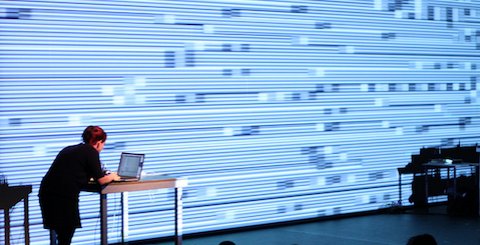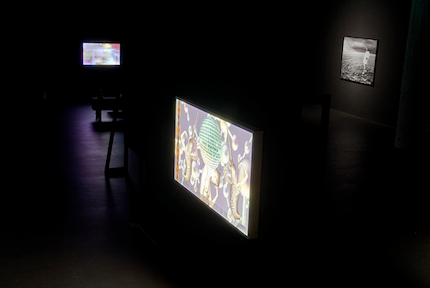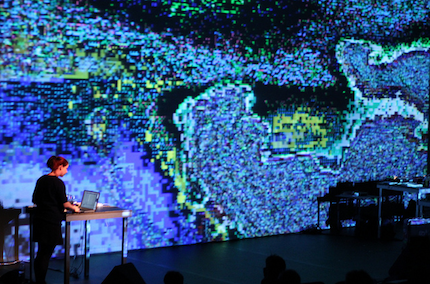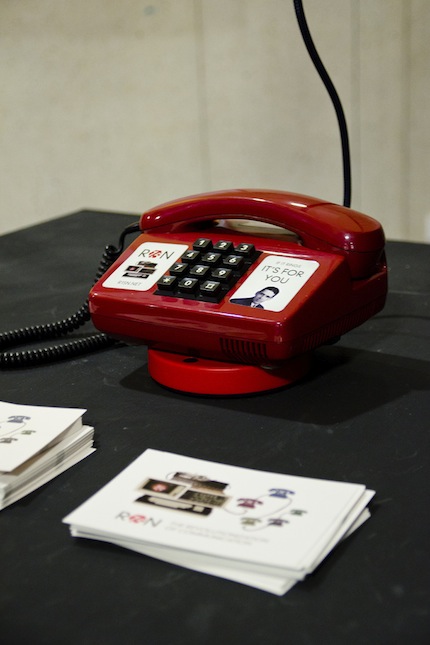
The return of art manifestos
Toms Ķencis
22/02/2012
The fine arts are articulated into discourse in several ways; however, usually it happens either post-factum or externally to the field of arts. An art history might serve as a fine example of the former, and governmental policy – of the latter. In this regard, so-called art or artists’ manifestos are a unique genre – a programmatic statement of purposes evaluating the current state of arts and proposing possible future developments from the perspective of creators, i.e. artists, instead of scholars, critics or politicians. Initially, a manifesto was a piece of evidence in a court of law, put on show to catch the eye, a public declaration; but the genre, as we know it today, has its roots in political documents of the 19th century. Any manifesto – political and artists’ alike – signifies the presence of more than one legitimating discourse within the particular field of activity; thus, one can say – the appearance of a manifesto serves as a signal of a certain crisis. A manifesto is simultaneously a diagnosis and a document of ideology, created to convince and convert. It is also a way how an artist speaks to her audience, crafting and legitimizing a new identity in the act of speaking, i.e. using her initial right to articulate it, instead of being categorized by someone else. Offering something new, the authors of manifestos stand for change, and thus often criticize, oppose and deny the status quo. The political dimension and orientation towards the future highlight manifestos among similar genres, such as curatorial statements or artistic conceptions. Formally, art manifestos usually represent a particular movement or a group of persons rather than individual artists; often they are written in a form of numbered statements and tend to use extreme means of language.
Historically, the first art manifesto belongs to the Italian futurists; it was The Founding and Manifesto of Futurism, written by poet and journalist Filippo Tommaso Marinetti in 1909. Up until World War II, it was followed by such classics as Vorticist manifesto (1914), Dada manifesto (1916), Surrealist manifesto (1924), and Manifesto Towards a Free Revolutionary Art (1938), the latter being authored by no one else than surrealist André Breton and Russian revolutionary Leon Trotsky. In general, these early examples show a necessity to explain the radical rejection of tradition, as well as the utopian belief of changing the world via the arts. The post-war situation introduced, on the one hand, a different political culture and, on the other hand, a certain alienation of the public sphere, with fine arts residing more within the narrow domain of professional activities. New manifestos reflected the resentment towards the lost hopes of the early avant-garde to change society, and the increasing fragmentation of the contemporary art scene. The internet era brought with it an enormous increase of textual production but, at the same time, increasing marginalization of the manifestos – it’s been a long time since they were the talk of the day. However, the most recent endeavours to find a new language of and for the arts, and to re-position the field within the shifting boundaries between social activism, aesthetics, technologies and different contradictory currents of discourse, have resulted in the return of the art manifestos, bearing the old, good pretensions of the avant-garde -- to change society and the arts. An example of such a pattern in recent times would be the materials displayed and published in the intermediale 2k+12 festival (January 28 – February 5, Berlin, Germany).

A Cyberfeminist Manifesto for the 21st Century by VNS Matrix © Genz, Lindner / transmediale
First of all, it’s the re-actualization of the genre by exhibiting a lightbox of A Cyberfeminist Manifesto for the 21st Century. Created in 1991 by a group called VNS Matrix, it entertainingly unites prophetic technological statements (the famous movie Matrix was made ten years later) with speech characteristic to radical feminism. "We are the modern cunt", it begins, and then fiercely develops so:
"we believe in jouissance madness holiness and poetry
we are the new world disorder
rupturing the symbolic from within
saboteurs of big daddy mainframe
the clitoris is a direct line to the matrix"
As in this case, with or without a dose of irony, manifestos often are so revolutionary in their content that it requires revolutional revision of language, grammar, and typography: the old language cannot communicate the ultimate novelty manifestos propose. While this historical piece occupied the exhibition space, the most recent manifestos were published in transmediale festival's reSource newspaper, World of the News. "The world's greatest peer-reviewed newspaper of in/compatible research" serves as a platform for knowledge exchange and research across disparate fields of practice. Based on a PhD workshop and conference held in Berlin in November 2011, it provides an insight into current research from academics, practitioners, and Ph.D. students working with in/compatibility, the 2012 transmediale festival theme. Further, you will find an overview of four (and a half) manifestos included in the current issue.
1. Against psychopathia medialis – for normal schizophrenia. A minimal manifesto
Foregrounding in the title the familiar manifesto trope “against/for”, and further exploiting the typical first person plural, the author Siegfried Zielinski merges insights from media studies, psychiatry, and philosophy with the intention of proposing a new approach to media art and life. The Prof. Dr.: Chair for media theory/archaeology and variantology of the media (Berlin University of the Arts) and Michel-Foucault-professor for techno-aesthetics and media archaeology (European Graduate School Saas Fee), in 23 points would rather offer guidance through the contemporary media-scape than sketch new models of aesthetic production. For example:
"19. To avoid an existence that is caught up too much within time and is therefore paranoid, and to avoid being too little within time and therefore thinking one is at home on the rings of Saturn in melancholy and bitterness, it is helpful as a principle to cultivate the conscious split. We work, organise, publish, and amuse ourselves in networks. We rhapsodise, meditate, enjoy, believe, and trust in autonomous, separate situations, each to his/her own and sometimes with other individuals. This adds up to a balancing act: in a single lifetime we have to learn to exist on-line and be offline. If we don't succeed in this, we shall become mere appendages of this world that we have created, merely its technical functions. We should not allow cybernetics, the science of optimal control and predictability, this triumph."
Saturated with references and quotes, this manifesto stands for new creativity, as well as new understanding, by re-positioning the subject within the dichotomy of technology and life; one could say, it is a projection of Gilles Deleuze's and Félix Guattari's historical anti-psychiatry program onto the contemporary situation, which is also the realm where the media arts articulate the creative output.
2. Glitch studies manifesto
Closest to "classical" art manifestos is the text by Rosa Menkman (Cologne, Germany) that demonstrates the endeavours of art theory to categorize artistic practices into genres. A conclusion, "This is why glitch studies is necessary," legitimizes a particular discipline by simultaneously constructing its object.

The Glitch Moment(um) by Rosa Menkman © Ania Domanska / transmediale
"3. Get away from the established action scripts and join the avant-garde of the unknown. Become a nomad of noise artifacts!
The static, linear notions of information-transmission can be interrupted on three occasions; during encoding-decoding (compression), feedback, or when a glitch (an unexpected break within the flow of technology) occurs. Noise artists must exploit these noise artifacts and explore the new opportunities they provide."
Looking at the long history of art manifestos, it mainly evokes associations with The Art of Noise, a manifesto on music written by Italian futurists in 1913. However, written by a student, audio/video performer and artist, Glitch studies manifesto stands for a niche of art and studies, using the common rhetoric of manifestos only formally.
3. M*anifesto for interfer!ng wom/en
Authored by musician and PhD student Marie Thompson (Newcastle University, UK), this manifesto is the most radical of recent examples regarding the use of language and grammar; no wonder, taking into account the rich tradition of feminist manifestos it is competing with.
"Noise politics = Cyborg politics = gender politics
Noise gives voice to Donna
Haraway's Cyborg
The Cyborg dwells on the border. It refuses the dualisms between nature/culture, natural/unnatural, human/machine. It is completely without innocence: IT is the offspring of WAR, PAtriARCHY, CaPitalism. BUT Cyborgs do NOT fit the oIDEpal narrative: it does not abide the law of the Father and thus, has no loyalty to figures that haunt its past. As such, it may become a noiSe within ThE systems that gave birth to it."
With intended typographic glitches and plenty of generalizations, this manifesto represents a pastiche recycling of the futurists' The Art of Noise and Donna Haraway's A Cyborg Manifesto (1985). On the one hand, the novelty characteristic of the genre is hopelessly overshadowed by echoes of the past; on the other hand, the manifesto presents in textual form its vision of artistic (musical) production.
4. Venture communism and copyfarleft. Extract from The Telekommunist Manifesto (50)
Software developer and co-founder of Telekommunisten, Dmytri Kleiner (Berlin, DE), presents a hard-core politico-economic analysis, thus resembling works of the first communists Karl Marx and Friedrich Engels. Without references to particular forms of arts, it is a treatise on artistic production in general:
"Whatever wealth producers can apply to influencing social institutions must come from the share of production they retain, and thus will always be smaller than the share retained by owners who can use it to prevent change. When we employ a commons of productive assets, which have no individual owners but are collectively owned, we retain the wealth we create, and thus the possibility for a new society is within our grasp."

R15N by Dmyrti Kleiner, Baruch Gottlieb, Jonas Frankki, Mike Pearce, Jeff Mann, and the Telekommunisten Network © Genz, Lindner / transmediale
What this manifesto lacks in terms of ordinary use of language is completely compensated with the idealistic belief in the possibility of a better world materialized, among all, by means of the arts.
5. Speculative archiving & experimental preservation of media art
Though it’s not a manifesto, the title of the text interestingly summarizes the poetics and politics of this genre and its history. A PhD student at the Interface Cultures Lab at the Art University Linz (Austria), Nina Wenhart offers a new method of archiving, at the same time contributing to the definition of new media arts. Even if not explicitly marked as a manifesto, the text still starts with a bold paraphrase:
"A spectre is haunting Media Art – the spectre of digital decay. All the powers of old-school archiving have entered into a holy alliance to exorcise the spectre; Academics and industry, Microsoft and Free Software, pirates and copyright law enforcers."
The originality here lies in using the opening lines of Manifesto of the Communist Party (1848) by Marx and Engels, a text of enormous influence and historical importance for later political and aesthetic proclamations. After a century of experiments, successful and failed revolutions, stylization and recreation, most recent art manifestos, again, turn to classical values – with a modicum of revolutionary zeal and perfectly mastered rhetorics of the genre.
Further reading
- Caws, Mary Ann. Manifesto: A Century of Isms. Lincoln, University of Nebraska Press: 2002.
- Danchev, Alex (ed.). 100 Artists’ Manifestos: From the Futurists to the Stuckists. Penguin Modern Classics: 2011.
- Kleiner, Dmytri. The Telekommunist Manifesto. Eds. Geert Lovnik and Sabina Niederer. Amsterdam, Institute of Network Cultures: 2010. Download at https://networkcultures.org/wpmu/portal/publications/network-notebooks/the-telekommunist/
- Somigli, Luca. Legitimizing the Artist: Manifesto Writing and European Modernism, 1885–1915. University of Toronto Press: 2003.
- World of the News. Vol. 1 - Issue 2. The transmediale reSource newspaper. Berlin, 2012. Downoad here.